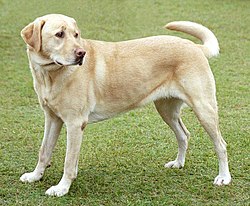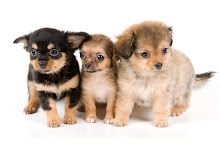
 The modern labrador's ancestors originated on the island of Newfoundland, now part of the province of Newfoundland and Labrador, Canada.[4] The breed emerged over time from the St. John's Water Dog, also an ancestor of the Newfoundland dog (to which the Labrador is closely related), through ad-hoc breedings by early settlers in the mid to late 16th century.[4] The original forebears of the St. John's dog are not known, but are likely a random-bred mix of English, Irish, and Portuguese working breeds. From the St. John's Dog, two breeds emerged; the larger was used for hauling, and evolved into the large and gentle Newfoundland dog, likely as a result of breeding with mastiffs brought to the island by the generations of Portuguese fishermen who had been fishing offshore since the 1600s. The smaller short-coat retrievers used for retrieval and pulling in nets from the water were the forebears of the English-bred Labrador Retriever. The white chest, feet, chin, and muzzle - known as tuxedo markings - characteristic of the St. John's Dog often appear in Lab mixes, and will occasionally manifest in Labs as a small white spot on the chest (known as a medallion) or stray white hairs on the feet or muzzle.
The modern labrador's ancestors originated on the island of Newfoundland, now part of the province of Newfoundland and Labrador, Canada.[4] The breed emerged over time from the St. John's Water Dog, also an ancestor of the Newfoundland dog (to which the Labrador is closely related), through ad-hoc breedings by early settlers in the mid to late 16th century.[4] The original forebears of the St. John's dog are not known, but are likely a random-bred mix of English, Irish, and Portuguese working breeds. From the St. John's Dog, two breeds emerged; the larger was used for hauling, and evolved into the large and gentle Newfoundland dog, likely as a result of breeding with mastiffs brought to the island by the generations of Portuguese fishermen who had been fishing offshore since the 1600s. The smaller short-coat retrievers used for retrieval and pulling in nets from the water were the forebears of the English-bred Labrador Retriever. The white chest, feet, chin, and muzzle - known as tuxedo markings - characteristic of the St. John's Dog often appear in Lab mixes, and will occasionally manifest in Labs as a small white spot on the chest (known as a medallion) or stray white hairs on the feet or muzzle.The St. John's area of Newfoundland was settled mainly by the English and Irish. Local fishermen originally used the St. John's dog to assist in bringing nets to shore; the dog would grab the floating corks on the ends of the nets and pull them to shore. A number of these were brought back to the Poole area of England in the early 1800s,[4] then the hub of the Newfoundland fishing trade, by the gentry, and became prized as sporting and waterfowl hunting dogs.[4] A few kennels breeding these grew up in England; at the same time a combination of sheep protection policy (Newfoundland) and rabies quarantine (England) led to their gradual demise in their country of origin.[5]
The first and second Earls of Malmesbury, who bred for duck shooting on his estate,[6] and the 5th and 6th Dukes of Buccleuch, and youngest son Lord George William Montagu-Douglas-Scott,[6]were instrumental in developing and establishing the modern Labrador breed in nineteenth century England. The dogs Avon ("Buccleuch Avon") and Ned given by Malmesbury to assist the Duke of Buccleuch's breeding program in the 1880s are usually considered the ancestors of all modern Labradors.[7]


No comments:
Post a Comment